Looking for delicious ways to prepare purple cabbage? You’ve come to the right place! This vibrant vegetable isn’t just a pop of color for your plate—it’s a versatile ingredient that can transform ordinary meals into extraordinary culinary experiences. Whether you prefer your cabbage braised, roasted, sautéed, or thinly sliced in a tangy slaw, these purple cabbage recipes will inspire your next kitchen creation. Not only is this cruciferous veggie packed with nutrients, but it also pairs well with countless flavors, from sweet and sour to savory and spiced. Join me as we explore my favorite ways to cook with this beautiful, budget-friendly vegetable that deserves a starring role in your weekly meal planning.
Table of Contents
Why You’ll Love Purple Cabbage Recipes
Purple cabbage recipes transform everyday meals with their striking color and versatility. More nutritious than green cabbage, it offers a slightly sweeter flavor that mellows beautifully when cooked. These recipes use simple pantry staples to create dishes that range from vibrant salads to comforting braised sides, all delivering impressive results with minimal effort.
Ingredients for Purple Cabbage Recipes
Purple cabbage dishes don’t require complicated shopping lists. Most recipes call for everyday items you likely have on hand, making these dishes both accessible and economical for weeknight cooking. Explore how to choose quality ingredients for cooking at The Spruce Eats.
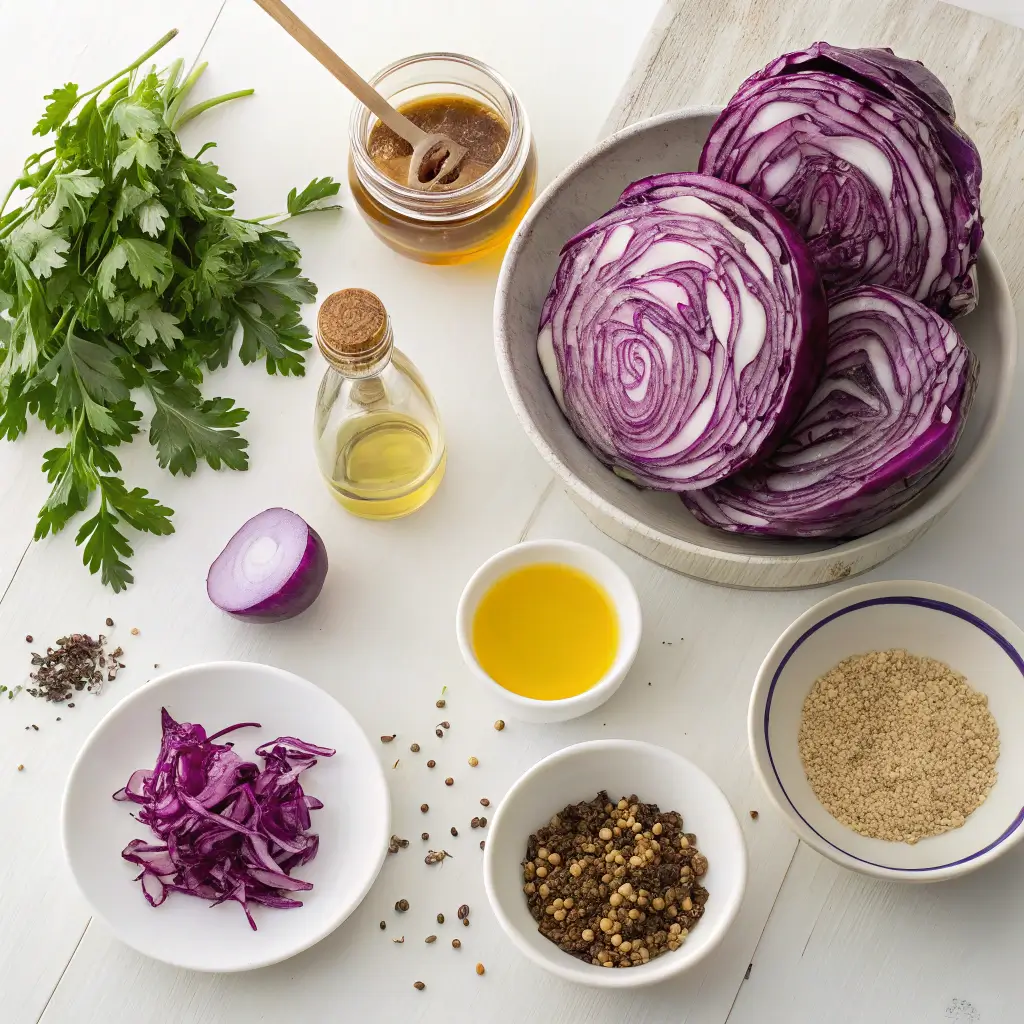
Core Ingredients
- Purple Cabbage: Look for a firm, heavy head with vibrant color and crisp leaves. A medium-sized purple cabbage, weighing around 2 pounds, typically produces between 8 to 10 cups once shredded.
- Oils and Fats: Olive oil, butter, or sesame oil provide rich foundations for different recipe styles.
- Acidic Components: Vinegar is essential for balancing cabbage’s flavor—red wine vinegar, apple cider vinegar, or balsamic vinegar all work beautifully.
- Sweeteners: A touch of honey, maple syrup, or brown sugar helps counteract bitterness.
- Aromatics: Garlic, onions, and shallots build flavor depth.
- Seasonings: Salt, pepper, caraway seeds, and bay leaves are traditional companions.
Recipe-Specific Additions
- For German Red Cabbage: Apples, cloves, juniper berries, and bacon
- For Asian-Inspired Slaws: Ginger, sesame seeds, scallions, and rice vinegar
- For Braised Dishes: Vegetable or chicken broth, wine, and herbs
- For Fresh Salads: Citrus segments, nuts, dried fruits, and tangy dressings
How to Make Purple Cabbage Recipes
Preparing purple cabbage is straightforward once you master a few basic techniques. These methods can be adapted for different flavor profiles while maintaining the vegetable’s nutritional benefits and vibrant color.
Preparation Basics
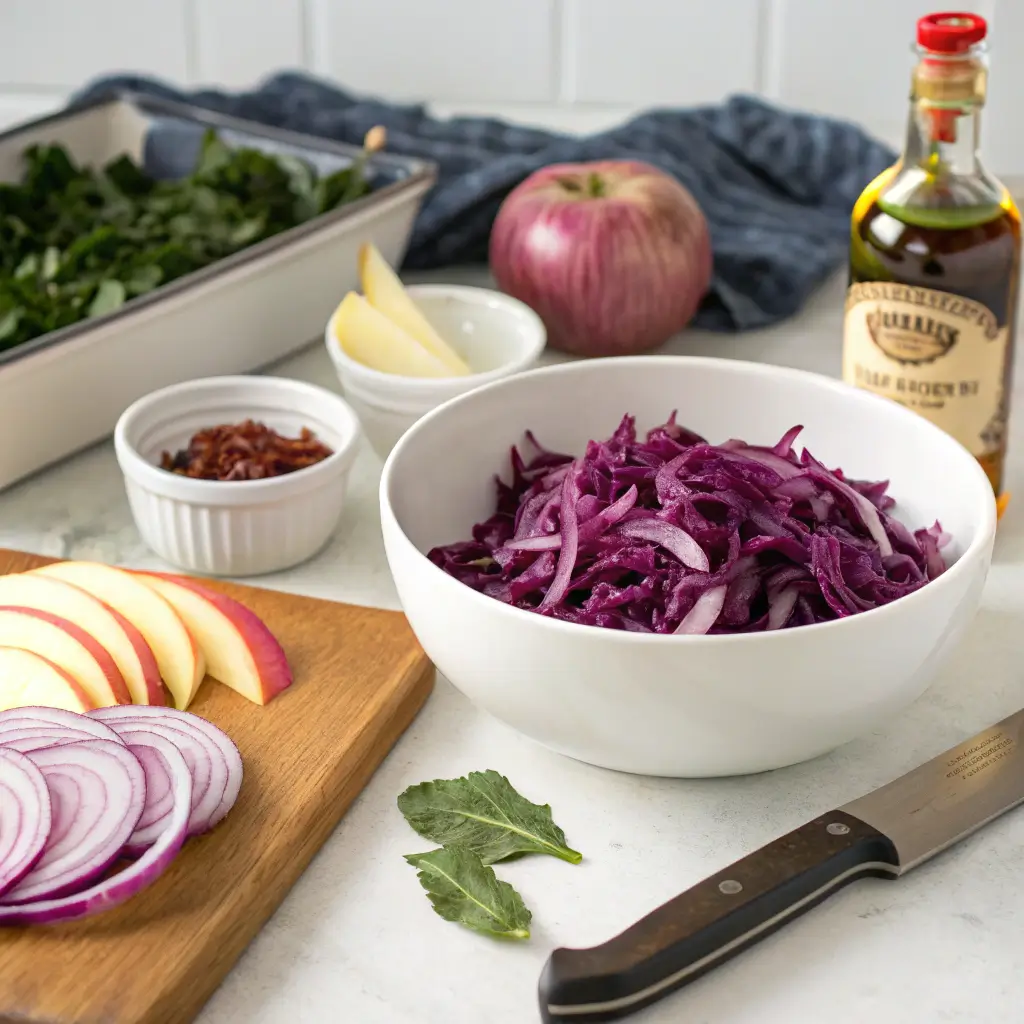
- Cleaning: Start by peeling away any wilted or discolored outer leaves from the cabbage.
- Cutting: Cut the cabbage in half through the core, then remove the tough core by cutting a V-shape around it.
- Slicing: For most recipes, thinly slice the cabbage—aim for consistent thickness for even cooking.
- Rinsing: Give the sliced cabbage a quick rinse and pat dry if needed.
Cooking Methods
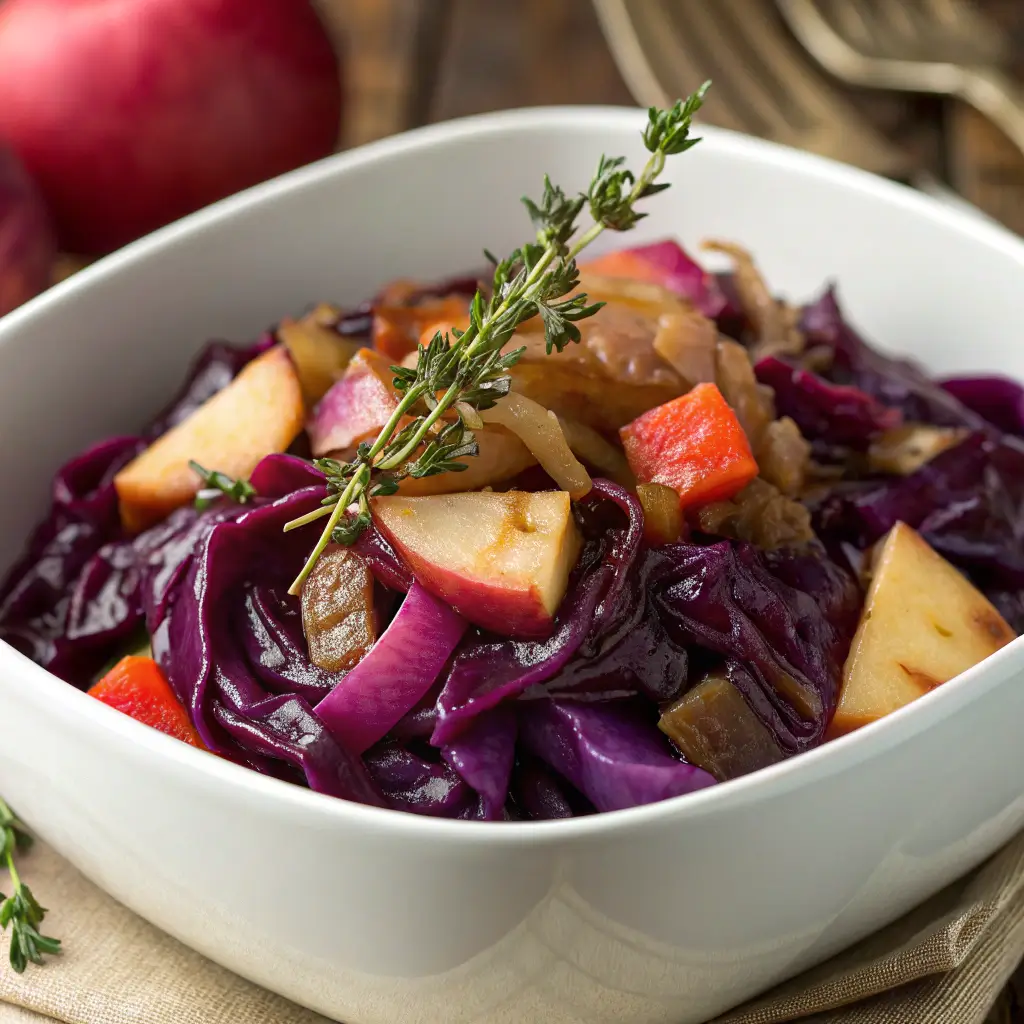
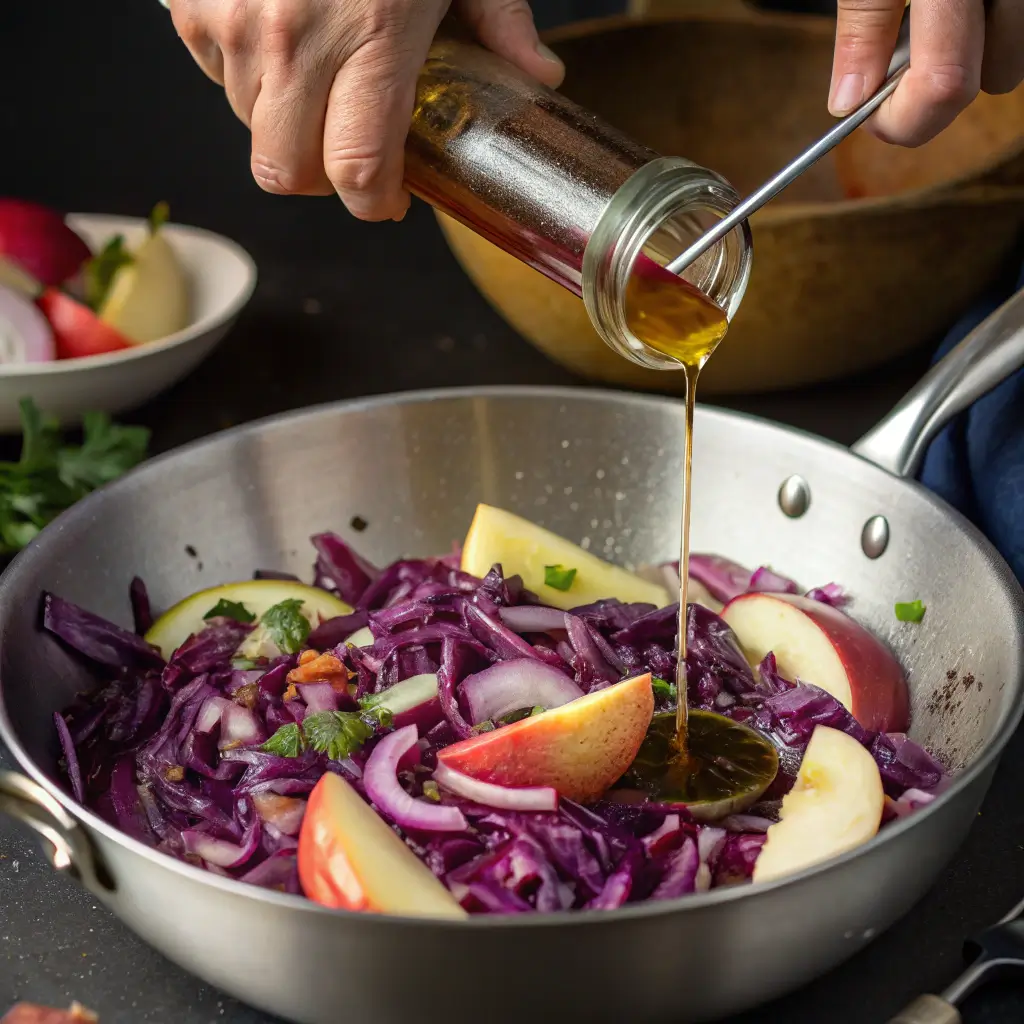
For Braised Purple Cabbage :
- Heat butter or oil in a Dutch oven over medium heat.
- Add aromatics like onion and garlic, sautéing until fragrant.
- Stir in the thinly sliced cabbage, making sure it’s evenly coated with the oil or butter.
- Pour in liquid (broth, wine, or vinegar), add seasonings, and cover.
- Simmer on low heat for 45-60 minutes, stirring occasionally until tender.
For Quick-Sautéed Cabbage:
- Warm a bit of oil in a wide skillet set over medium-high heat.
- Add cabbage and seasonings, tossing frequently.
- Cook for 5-7 minutes until slightly wilted but still crisp.
- Finish with a splash of vinegar or citrus juice.
Serving Suggestions
Purple cabbage elevates everyday meals with its striking color and distinctive flavor. Here are thoughtful pairings to showcase this versatile vegetable across different cuisines and meal occasions. See pairing ideas and tips at Bon Appétit.
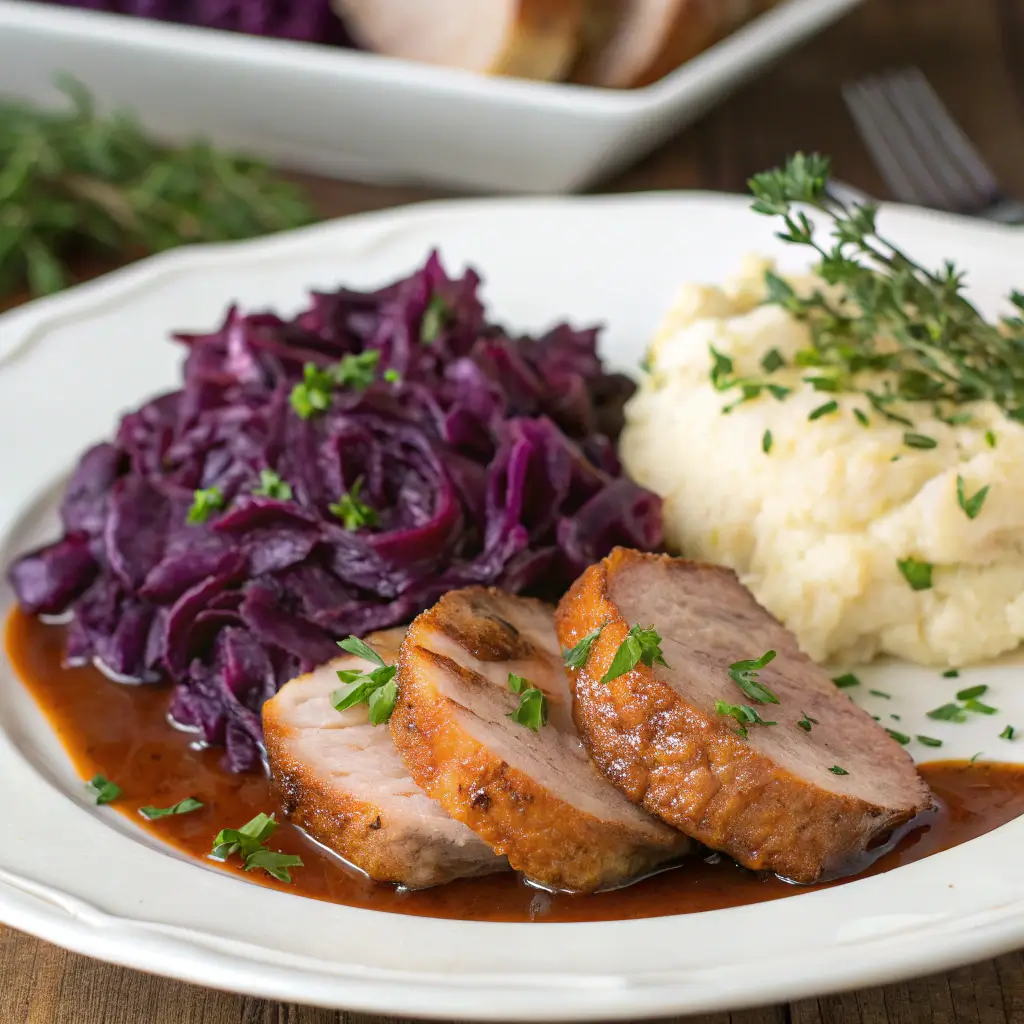
Pairing with Proteins
Meat Companions:
- Use braised purple cabbage as a bed for sliced pork tenderloin with a drizzle of balsamic glaze.
- Serve warm spiced cabbage alongside game meats like venison or rabbit for traditional flavor contrasts.
- Top fish tacos with fresh purple cabbage slaw for texture and visual appeal.
- Offer tangy cabbage alongside smoked brisket or grilled sausages at your next cookout.
Vegetarian Combinations:
- Nestle purple cabbage alongside stuffed mushrooms for an elegant plant-based main.
- Incorporate warm cabbage into lentil dishes for added texture and nutrition.
- Create colorful Buddha bowls with purple cabbage, roasted vegetables, and your favorite protein.
International Menu Ideas
- Central European: Complement schnitzel and potatoes with wine-braised purple cabbage.
- Nordic Inspired: Serve quick-pickled cabbage strips with gravlax and rye bread.
- Mediterranean Style: Pair cabbage-apple slaw with grilled kebabs and flatbread.
- North American Comfort: Add warm cabbage to holiday turkey dinners as a colorful side option.
Tips & Variations
Enhance your purple cabbage recipes with these handy tips and imaginative variations. These suggestions will help you customize recipes while ensuring consistent results, whether you’re a novice or experienced cook.
Cooking Tips
Preserving Color:
- Add a tablespoon of vinegar or lemon juice to cooking liquid to maintain the vibrant purple hue.
- Refrain from using cast iron cookware for red cabbage, as it may alter the vegetable’s color.
- Cook in glass, enamel, or stainless steel pots to keep colors true.
Flavor Enhancement:
- Balance the natural bitterness by adding a touch of honey, maple syrup, or brown sugar.
- Toast spices before adding them to release more aroma.
- Let braised cabbage rest overnight—the flavors develop beautifully with time.
Texture Control:
- For crunchier slaws, salt shredded cabbage and let it stand for 20 minutes, then rinse and thoroughly dry.
- When braising, check liquid levels frequently to prevent burning.
Creative Variations
Regional Inspirations:
- Polish-style: Add grated apple, caraway seeds, and a splash of apple cider.
- Asian-inspired: Incorporate ginger, garlic, and a dash of five-spice powder.
- Mediterranean Twist: Add fennel seeds, a hint of orange zest, and sweet golden raisins for a vibrant flavor combo.
Preparation Alternatives:
- Try quick-pickling for tangy sandwich toppings or taco garnishes.
- Roast cabbage wedges until edges caramelize for a completely different flavor profile.
- Ferment purple cabbage for probiotic-rich homemade sauerkraut with stunning color.
Nutritional Information for Purple Cabbage Recipes
Purple cabbage isn’t just visually striking—it’s a nutritional powerhouse that offers impressive health benefits while adding vibrant color to your meals. Understanding its nutritional profile can help you make the most of this versatile vegetable.
Key Nutrients in Purple Cabbage
Purple cabbage stands out from its green counterpart due to its higher concentration of anthocyanins—the pigments responsible for its deep purple hue. These potent antioxidants work to reduce inflammation and shield your cells from harm. A one-cup serving (about 89g) of raw purple cabbage contains approximately 28 calories, making it an excellent low-calorie addition to any diet.
This cruciferous vegetable is packed with vitamins, particularly vitamin C—just one cup provides about 56% of your daily needs. It’s also rich in vitamin K, which supports bone health and proper blood clotting. Purple cabbage contains good amounts of vitamin B6, folate, and manganese, along with smaller quantities of calcium, potassium, and magnesium.
Health Benefits of Including Purple Cabbage in Your Diet
Regular consumption of purple cabbage may help reduce the risk of chronic diseases thanks to its anti-inflammatory properties. The high fiber content (about 2g per cup) supports digestive health and helps maintain healthy blood sugar levels. Studies suggest that the compounds in purple cabbage may also play a role in cancer prevention by helping to eliminate potential carcinogens from the body.
The vitamin C content strengthens your immune system, while the vitamin K improves calcium absorption and bone strength. For those watching their weight, purple cabbage offers satisfying crunch and flavor without adding many calories to meals.
Discover the full nutritional benefits of purple cabbage on WebMD.
FAQs
What is the best way to eat purple cabbage?
Purple cabbage can be enjoyed both raw and cooked. Raw cabbage works wonderfully in slaws, salads, and as a crunchy sandwich topping. When cooked, try braising, sautéing, roasting, or stir-frying for different textures and flavors. German-style braised cabbage with apple cider vinegar and a touch of sweetness is a classic preparation that brings out its best qualities.
What can I make out of purple cabbage?
The options are nearly endless! Beyond traditional coleslaw, you can make tangy quick-pickled cabbage, vibrant salads, hearty braised side dishes, colorful stir-fries, and even cabbage steaks. Purple cabbage also works beautifully in slaws paired with apples and carrots, adds color to grain bowls, and makes an excellent filling for tacos or topping for burgers.
Can you cook purple cabbage the same as green cabbage?
Yes, purple cabbage can be prepared using the same methods as green cabbage. However, it typically has a slightly stronger flavor and denser texture, which may require slightly longer cooking times. The purple pigment will also transfer to other ingredients, so be mindful when combining with lighter-colored foods.
How do you take the bitterness out of purple cabbage?
To reduce bitterness in purple cabbage, try soaking shredded cabbage in cold water for 15-30 minutes before using. Adding a small amount of acid like vinegar or lemon juice during cooking helps balance flavors. For braised dishes, including a touch of sweetness from sugar, honey, or apple can effectively counteract any bitter notes while enhancing the cabbage’s natural flavors.
Conclusion & Call to Action
Purple cabbage recipes offer a perfect blend of nutrition, versatility, and visual appeal for your table. This vibrant vegetable transforms ordinary meals into colorful culinary experiences while providing impressive health benefits.
Whether you’ve chosen to braise it German-style, toss it into a tangy slaw, or roast it to caramelized perfection, purple cabbage deserves a regular spot in your meal rotation. The recipes shared here are just the beginning of your purple cabbage journey.
Have you tried any of these preparation methods? We’d love to hear which purple cabbage recipes became your favorite! Share your experiences, variations, or questions in the comments below—your feedback helps our cooking community grow together

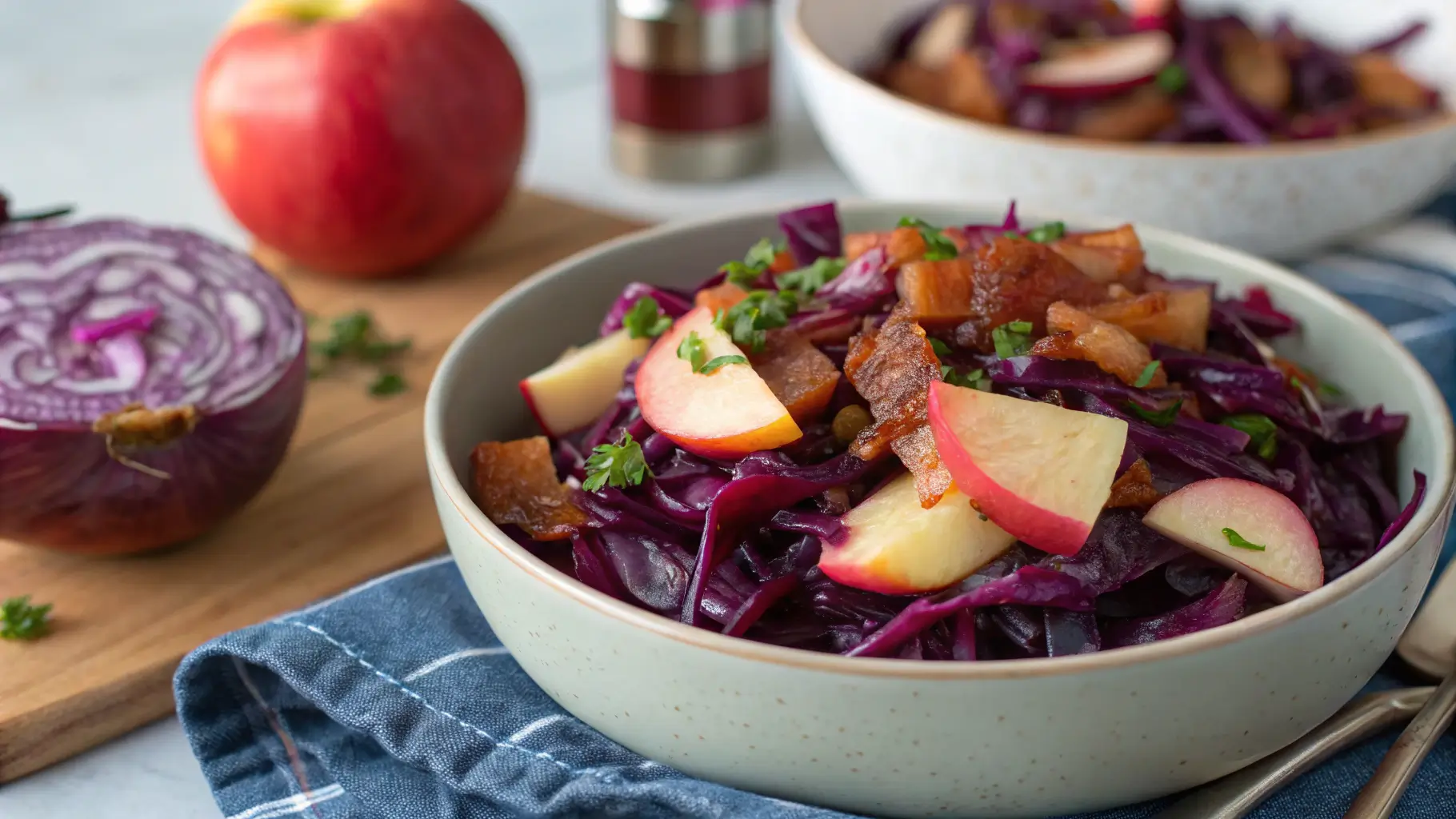
2 thoughts on “Purple Cabbage Recipes You’ll Love”